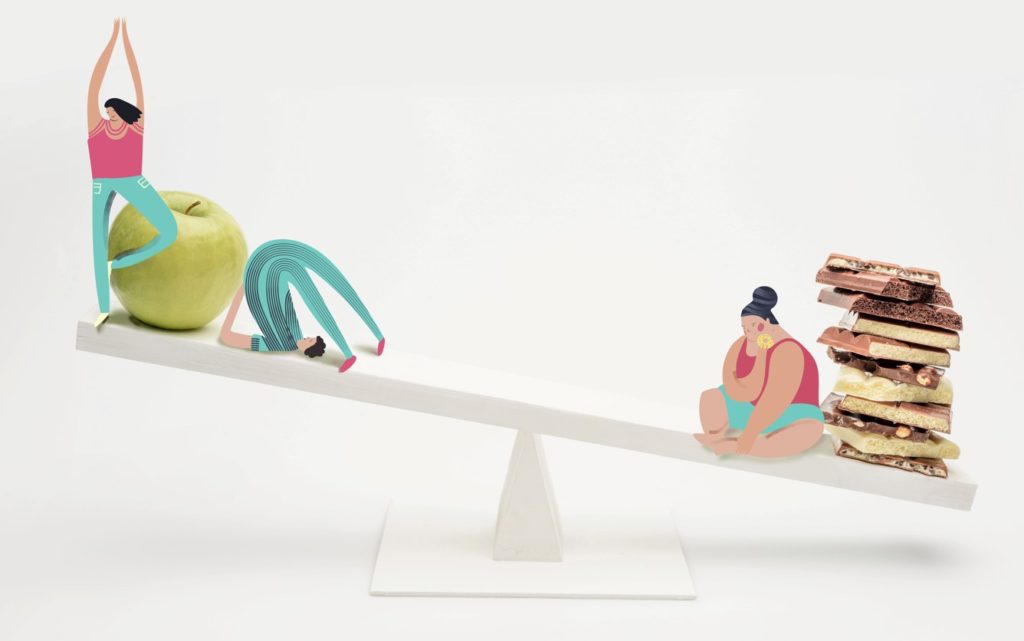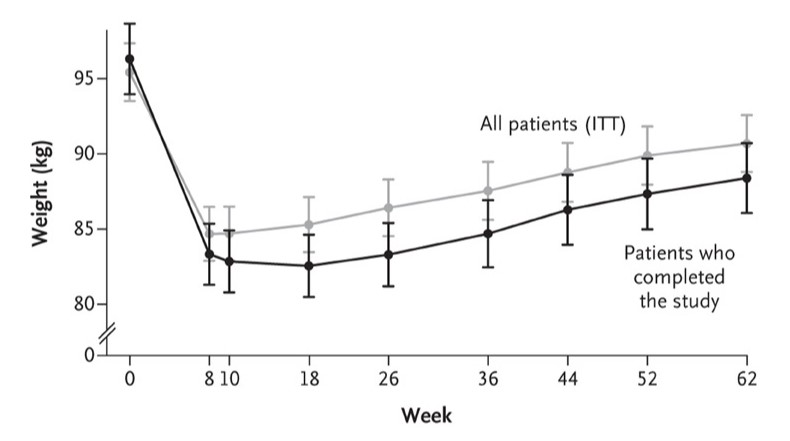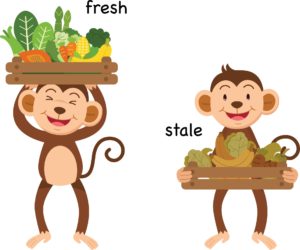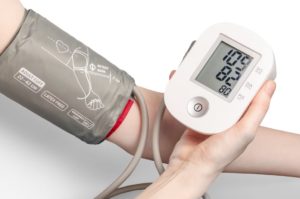It’s a familiar scene to anyone who has attempted a weight loss diet plan. You make staggeringly good progress in the first couple of weeks, but then mysteriously, the rapid downward slope of your weight chart begins to tail off, and sometimes you may find it can start rising again even though you haven’t consciously changed anything! It can be very demoralizing for all but the most battle-hardened dieters, so it makes sense to delve into the science and the psychology behind this unwanted leveling-off.
Reasons For A Weight Loss Plateau
There can be a several reasons for your weight loss progress tailing off. Some or all of these may combine to produce the overall effect:
Novelty Wanes
The novelty of your new routine may be starting to wear off, and you can find yourself slipping back into old habits. This is especially true if your diet plan involves a lot of changes to the way you normally eat. Withdrawal symptoms can be one of the main reasons people give up on their diet plans and can make it difficult to stick to even the most well-designed program.
Brain Receptors
 Your brain (specifically the hypothalamus) and the body itself can start to get used to the same routine (be it diet or exercise), and this can lead to a plateau in your weight loss efforts. In effect, this is your metabolism slowing down when the body detects that calories have dropped. The body goes into survival mode and starts to conserve energy as much as possible. The upshot of this is that not as many calories get burnt, and fat gets stored when you want the polar opposite to happen.
Your brain (specifically the hypothalamus) and the body itself can start to get used to the same routine (be it diet or exercise), and this can lead to a plateau in your weight loss efforts. In effect, this is your metabolism slowing down when the body detects that calories have dropped. The body goes into survival mode and starts to conserve energy as much as possible. The upshot of this is that not as many calories get burnt, and fat gets stored when you want the polar opposite to happen.
Water – and not drinking enough of it.
 This is quite an obvious factor, but easy to overlook. Our bodies are composed of 60% water, and if you don’t drink enough to replace lost fluids, several health problems can be encountered, including weight gain. Make sure you’re drinking plenty of fluids – at least 8-10 glasses throughout the day. This can also help maintain a feeling of fullness and avoid seeking out the snack cupboard.
This is quite an obvious factor, but easy to overlook. Our bodies are composed of 60% water, and if you don’t drink enough to replace lost fluids, several health problems can be encountered, including weight gain. Make sure you’re drinking plenty of fluids – at least 8-10 glasses throughout the day. This can also help maintain a feeling of fullness and avoid seeking out the snack cupboard.
Junk Food
 Not normally a problem if you’re following a healthy diet plan, but it’s always easy to slip up and say, “well, one Big Mac won’t matter too much, will it?”. Processed foods like Big Macs are high in sodium and unhealthy fats, contributing to weight gain. Not only that, but some research has shown that the brain’s reward centers are triggered more strongly by junk food after you’ve been dieting for a while. It just seems so much more important to be naughty when you’ve been doing so well. Try and stay mindful of the risks to your hard-earned progress if you succumb like this.
Not normally a problem if you’re following a healthy diet plan, but it’s always easy to slip up and say, “well, one Big Mac won’t matter too much, will it?”. Processed foods like Big Macs are high in sodium and unhealthy fats, contributing to weight gain. Not only that, but some research has shown that the brain’s reward centers are triggered more strongly by junk food after you’ve been dieting for a while. It just seems so much more important to be naughty when you’ve been doing so well. Try and stay mindful of the risks to your hard-earned progress if you succumb like this.
Skipping meals
 When you skip meals, your body can again go into starvation mode, and it will begin to store fat instead of burning it off. Make sure you’re eating regular meals or meal-replacement shakes to avoid this negative bodily response. We’ve also seen good results with fat-burning supplements to maintain calorie burn through this stage.
When you skip meals, your body can again go into starvation mode, and it will begin to store fat instead of burning it off. Make sure you’re eating regular meals or meal-replacement shakes to avoid this negative bodily response. We’ve also seen good results with fat-burning supplements to maintain calorie burn through this stage.
Unconscious binge eating
 Similar to a) above, but more of an automatic response. You may not even be aware that you are doing it, but you end up eating a lot more than you meant to. This can be caused by stress, boredom, or other emotions that are coupled with your body’s hunger from the diet. It is very easy to raid the fridge late at night when you’re on a diet, especially if you’ve also been drinking alcohol. I’ve been there!
Similar to a) above, but more of an automatic response. You may not even be aware that you are doing it, but you end up eating a lot more than you meant to. This can be caused by stress, boredom, or other emotions that are coupled with your body’s hunger from the diet. It is very easy to raid the fridge late at night when you’re on a diet, especially if you’ve also been drinking alcohol. I’ve been there!

The science behind Weight Loss Plateauing
So what is going on here? A seminal research paper was published in 2011 entitled “Long-Term Persistence of Hormonal Adaptations to Weight Loss.” In this paper, the scientists enlisted 50 volunteers for a weight-loss experiment staged over ten weeks. The volunteers were all in a BMI range of 27-40, spreading well into ‘dangerously obese’ levels at >30.
They first embarked on a weight-loss phase for eight weeks whereby they massively dropped their calorie intake using meal-replacement shakes. The daily calorie count was around 500-550 per day.
After the eight weeks, those participants who had lost 10% of their body weight were shown how to maintain their weight at the new lower level and weened off the meal replacement shakes by week 10.
So what happened in the weight loss experiment?
The scientists monitored the levels of a wide range of hormones in the volunteer’s bodies, including leptin which is a regulator of appetite. Leptin tells the hypothalamus whether to do something about the ongoing weight loss. This is an evolutionary mechanism that could mean the difference between life and death if the lack of food and calories was occurring in the wild.
In the experiment, the levels of leptin, as well as other hormones like ghrelin and gastric inhibitory polypeptide, increased following the crash diet. This made the volunteers subconsciously want to eat more for up to a year after the ten-week diet. Crazy! Nearly all the participants put back on significant weight even though they were trying their hardest to maintain the lower weight they had achieved. See the chart below which has been reproduced without permission from the paper for reference purposes.

In simple terms, the body has been shown to have an in-built self-compensating mechanism that counteracts the effects of rapid weight loss. This means that we need to devise sneaky ways to avoid this during our diet programs if we are not to find ourselves back where we started at a later date.

Ways of Breaking The Plateau
So what do we do about the weight loss plateau? Well, essentially, you must periodically kick-start your body as you make progress with your diet. This doesn’t mean that you need to drop your daily calorie intake progressively throughout the dieting period – this wouldn’t work because eventually you wouldn’t be eating anything! No, instead you need to “mix things up” as time progresses. Let’s have a look how that can be achieved:
1. Change Your Diet
You could try changing your diet in different ways. For example, you could try:
- Increasing the amount of protein you consume (this will help keep you fuller longer).
- Adding some fat to your meals. Slightly counter-intuitive, but fat helps slow down digestion and is an essential factor in the well-known Keto diet.
2. Step up the workouts
For instance:
- Try some high-intensity cardio or interval training.
- Do a little bit of strength training each week.
- Try to increase the number of times you work out each week.
- Consider adding some resistance training or vibration workouts to your routine.
3. Better Diet Tracking
Try tracking your calories better and monitoring your weight and body fat. There are countless apps like myfitnesspal which enable you to record everything you eat – you can then see in black and white (and sometimes colour!) how much you might be eating when you don’t realize it.
4. Consider Taking Supplements
Controversial, but you may consider taking supplements to focus your mind on the diet and increase your metabolism. While we wouldn’t recommend taking these over the long term, we’ve found that they can work over three months to leapfrog you over that plateau. There may be some placebo effect involved with this benefit, but we have performed some small trials which seem to highlight a definite improvement in body fat when taking supplements like PhenQ and Prime Shred.
5. Mix up your routine
If you go to the gym after work, try going first thing in the morning before work. Take up a new sport, or walk the dog over a hilly route. Life is about trying different things, and if you push yourself out of the daily habits, it can help apply that kick start to your diet. The plateau will be long gone.
6. Periodic Rewards
Finally, don’t forget to reward yourself when you reach certain milestones with your weight. Again, this may seem counter-intuitive, but you will not survive your new lifestyle if you have to live like a monk forever. Having a few controlled drinks or even a calorie blowout once a month will not derail your diet too much – the key is to mentally prepare for it like a birthday or similar. A day when you’re going to celebrate and not worry too much about the consequences: just be ready to dive straight back into your diet afterward.

The Ultimate Way to Overcome the Weight Loss Plateau
Ultimately, you need to get your brain used to having less weight on board. Being lighter and consuming fewer bad calories needs to become the new normal for you so that the homeostasis feedback loop gets broken and you don’t relapse.
Research has shown that the “set point weight” of your body (which is a term used to describe how much your brain “thinks” you should weigh) can be lowered if you eat food as nature intended. This means eating simple, natural food like nuts, seeds, berries, and vegetables. Cut out the sugary M&Ms and replace them with simple salted peanuts. Replace fried chicken with grilled chicken etc.
These foods are all quite low density in terms of calories. The aim behind the plan is to eventually stop fretting about following a diet and stay healthily eating without stressing about it. This is often the biggest factor in lapsing with your diet – you’re constantly thinking about it and giving it too much attention. Better to eat intuitively by naturally gravitating to low-calorie foods if you can, and you will stabilize at a lower overall weight.
Sounds too good to be true? Well, try giving it a go…















